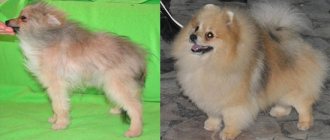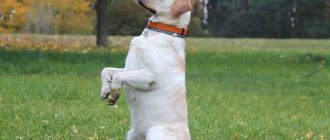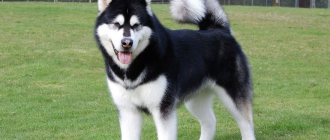If the Pomeranian is trained (Spitz Training) from puppyhood, then the “Voice” command is usually taught at the age of 4-6 months. Having learned in more detail about how to teach a Spitz the “Voice” command, you can understand that such training is simple for both the owner and the pet. Team training is carried out thanks to two main points:
- Two irritants. Voice command and gestures;
- Two types of incentives. In the form of praise and feeding or toys.
Characteristics of Spitz
It is impossible to raise an obedient Spitz without understanding his psychology and temperament. First of all, it is worth learning that a dog thinks differently than a person. She does not build complex logical chains; she acts based on innate instincts and acquired reflexes.
It is on instincts and reflexes that the education of a Spitz is based. It is necessary to develop the dog’s natural qualities and build the right associations: “a good deed is reward”, “a bad action is punishment”.
The Pomeranian is an open, intelligent dog that quickly learns commands and tries to please its owner. Anyone can handle her training. But sometimes education stalls, and the dog turns into a spoiled tyrant.
The reasons for unsuccessful training lie in the disadvantages of the Spitz’s character. They:
- Stubborn. Favorites stand their ground to the last, and obey only when they understand that the owner will not back down;
- Dominant. If trained incorrectly, the pet will imagine itself to be in charge and will do everything to make the owner’s life revolve around its desires;
- Manipulators . In this, dogs have no equal, they subtly feel people’s emotions, understand how amazing they are and take advantage of it.
The German Spitz is an artist like no other. The dog skillfully presses on pity, guilt, and love of the owner. Among the manipulator's arsenal:
- sad or begging faces;
- grievances - going to another room, unwillingness to communicate with the owner, refusal to eat, play;
- barking, whining, howling;
- hysterics - Spitz squeal worse than piglets when trying to punish them, send them to their place, fasten a leash and other actions that infringe on the freedom of pets.
Keep in mind that Spitz love to play. Moreover, both puppies and older dogs frolic. Therefore, the classes are made humorous, they are conducted as if by the way.
The character of a German Spitz boy is more dominant and stubborn, while a girl’s character is flexible and affectionate. But both masterfully manipulate people.
When to start raising a Pomeranian
Owners, accustomed to old methods of training, begin to raise a German Spitz from a certain age, and before that they allow the dog to do whatever he wants. This is a fundamentally wrong position. You need to start training a Spitz from the first minute you meet him. It’s easier to immediately explain to your pet what is not allowed or possible, than to wean him off bad habits later.
Education and training are not rigid drills. This is establishing a connection between a person and an animal, instilling the right skills. You need to train a German Spitz the same way as a three-year-old child: gently but persistently introduce him to the world, explain what is bad and what is good.
There are general recommendations for training a dog at different ages:
- at 1-2 months the kitten is introduced to the house, family, accustomed to a nickname, a toilet, general rules of behavior, prohibition commands;
- at 3-4 months, training a puppy, in addition to prohibiting commands, includes the orders “Place”, “Come to me”;
- at 4-6 months, the arsenal of skills is expanded with a general training course (GTC), it is not yet necessary to achieve 100% obedience and perfect execution of orders, the main thing is that the baby masters the skills;
- from 6-8 months they begin to seriously train the dog - up to a year they correct all the shortcomings made at the previous stages, requiring the pet to immediately and correctly follow orders.
Why is this necessary?
Having an obedient dog in the house is the desire of any Pomeranian owner. Noisy and cheerful boys and girls require constant attention. Males are especially characterized by a tough temperament, the desire to be first and to fight. Puppies bark a lot when left alone. They often chew shoes, crap and damage furniture. When walking, they behave aggressively towards other people and animals, and can bite. Therefore, early training is very important for representatives of this breed.
Regular training helps to establish an emotional connection and improves the relationship with your pet. The puppy lives according to a routine and it is easier for him to navigate when he needs to eat, go for a walk or sleep. He knows where his hiding place (his own safe place) is.
Basics of education
The first and main rule for training any dog is to establish hierarchical relationships. Dogs are social animals. And they perceive the family as a pack, where each member will play his role - from the owner to the hamster.
The roles are distributed as follows: alpha - the owner, after him - the spouse, parents, children, then - the rest of the pets, and at the end - the German Spitz. This is the only way the dog will obey.
In order for the dog to consider the owner as the leader of the pack, they follow simple training tips:
- feed the pet after they have eaten themselves;
- a person enters and exits first;
- on a walk, the owner walks ahead - the dog runs slightly behind, does not rush forward, does not pull on the leash;
- you cannot feed the dog from the table, or allow him to sleep on the bed - these are the attributes of a leader;
- when the game starts and ends is determined by the owner;
- biting, snarling, attempts to dominate are stopped immediately and harshly.
The rules are set once and for all. If a Pomeranian is not allowed to lie on the sofa, an exception cannot be made, even if he is sick. What the dog is allowed to do once, he will certainly repeat many times.
A daily routine will help in training a German Spitz. They determine the time of awakening, walks, classes, games, hygiene procedures, feeding, and rest. This makes it easier for your pet to navigate, and he develops the right habits.
Tips from dog handlers
If you choose independent training, dog trainers recommend adhering to the following tips:
- Consider the dog's character. All animals are unique and each of them requires a special training program, adjusted to a specific character.
- Seek professional help if you have difficulties. Don't be afraid to communicate with kennel club staff. They will definitely help in solving any problems, because this is what their main work is based on.
- Never make exceptions and avoid provocations. One mistake and the Spitz, feeling like a full-fledged authority, will begin to twist the rope out of the owner.
- Don't forget the importance of walking. Long walks are the key to keeping the little Energizer calm.
Once you become the owner of a little bundle of happiness, try to follow these recommendations. Remember that the specifics of training depend entirely on the character of the particular animal. You can’t put all dogs under the same brush, because they are all unique.
Training your pet on your own has the right to life and allows you to achieve maximum mutual understanding with your four-legged friend. Do your best and raise a pet that you can be truly proud of.
Types of training
You can teach a German Spitz basic commands using 3 training methods:
- Cynological. Suitable for beginner dog lovers. The pet is sent to a training school, where professionals work with it. Result 100%. Disadvantages: separation for 2-4 weeks, lack of relationship with the owner.
- Joint. The owner works with a German Spitz under the supervision of an instructor. The most reliable method. In addition, classes will be more necessary for a person than for a dog - he needs to learn how to interact correctly with a pet, understand him and speak the same language with him.
- Independent. Training a Spitz at home is not difficult, even if you have no experience. The main thing is to study thematic literature and videos. Plus – free training, building close relationships. And if something doesn’t work out, you can always contact a dog handler.
With any type of training, the dog can be taught using three different approaches to training:
- incentive - the pet is treated or praised after correctly following orders;
- mechanical: the owner helps the dog carry out the command - he presses on the withers, croup, pulls the leash, pulls it away with his hand, this way you can start the first training;
- contrasting - both methods of training are used.
Any training method is good. But it is better to resort to contrast - the German Spitz quickly learns commands that are simultaneously reinforced by physical influence and praise.
How to teach your Spitz commands yourself
Even beginners can train a Pomeranian at home. This is a smart dog, he remembers orders and tricks on the fly. You can teach commands yourself, the main thing is not to be fooled by provocations.
"Ugh" and "No"
You need to teach your Spitz the prohibition commands first. In a critical situation, they will save the fluffy's life.
There are 2 ban commands. They are considered the same, but the orders have different purposes:
- "Ugh". It means a categorical prohibition on an action that is performed here and now. They say it in a stern, intimidating voice.
- "It is forbidden". It prohibits something in the long term: climbing on the bed, carrying food, rummaging in the trash, following strangers. The order is also given strictly, but without threatening notes.
Spitz training for the “Fu” and “No” commands is the same. There are 3 ways:
- hold a treat in your fist, bring it to the German Spitz’s nose, command “Fu” or “No” when the dog stops reaching for the treat, encourage him;
- they do the same thing, only the treat or toy is not clutched in the fist, but placed not far from the student;
- if the pet does something inappropriate during a walk, the leash is sharply pulled back and “Ugh” is said.
The fidget prohibition command must be carried out immediately, always and everywhere.
"Give"
Skill training is carried out during games. When the puppy approaches the owner with a toy in his teeth, he fixes it with his fingers, says “Give” and carefully removes the object from his mouth. The thing is not pulled - the action is perceived by the dogs as an invitation to measure their strength.
"To me"
There is no more important command than “Come to me.” You need to teach your Spitz this order in the first weeks of life and practice the skill until it becomes automatic.
Training a Spitz to the “Come to me” command is simple, it is carried out like this:
- hold a treat in your hand and walk away a short distance;
- show a treat and pronounce an order;
- as soon as the dog approaches, it is encouraged;
- You can combine the order with pulling on the leash.
It is forbidden to scold the dog after carrying out the order “Come to me”. Even if he had previously “chewed” the neighbor’s cat, when the pet came up on command, he was only praised. Otherwise, your pet will develop negative associations and will not obey.
"Place"
Skill training is carried out immediately after the puppy appears in the house. The kitten is picked up and carried to his bed, saying the command “Place.” If the dog remains on the bedding, he is praised and treated. If it follows the owner, it is returned back.
A dog's place is sacred territory. Here you cannot scold the dog, forcefully pull it off the bedding, squeeze it, etc. German Spitz quickly understand this. Having played a prank, they rush headlong to the bed, avoiding being thrashed.
"Voice"
Spitz barks by nature, and teaching them the “Voice” command is easy. For this:
- hold a treat in your hand and tease the dog;
- raise your hand up without giving away the tasty treat;
- command “Voice” - the dog immediately barks, not understanding why it is not being given a treat.
Teaching the “Voice” command will help control the excessive talkativeness of Germans and teach them to bark only when ordered.
"Quiet"
The “Quiet” command is taught in tandem with the “Voice” order. For this:
- the pet is provoked to bark with a treat - as soon as he barks, they order “Voice”;
- they command “Quiet” and squeeze their mouth with their hand - if the dog continues to bark or struggle, the treat is not given;
- The pet is rewarded for correct behavior.
It is important to train the skill in involuntary situations. As soon as a German Spitz barks without a reason, they clamp his mouth and command “Quiet.”
"Sit"
The skill of endurance along with “Lie down”, “Stand”, “Wait”, “Place”. The “Sit” command is taught first, only then they move on to other orders for patience.
Training is carried out in 2 ways:
- they bring a treat over their head and take it back - reaching for the treat, the fluffy sits down, at which time they are ordered to “Sit”;
- command “Sit” and press on the pet’s croup.
"Lie"
They move on to the “Lie down” command after the “Sit” skill has been mastered. For training:
- make the dog sit;
- bring your hand with the treat to your nose, lower it down and at the same time move it back;
- the dog will reach for a treat and lie down - immediately order “Lie down”, reward the dog with praise and treats;
- if the pet does not lie down, press on the withers.
"Stand"
Teaching a Spitz this skill is difficult. Dogs are as mobile as mercury; it is difficult for them to remain in one place for a long time. But skill is needed. For this:
- put the dog next to your leg;
- say “Stand” and lift the pet under the belly;
- hold it for 5-10 seconds, encouraging it with your voice;
- praise and treats.
When the skill is practiced from a static position, they move on to walking training:
- stop abruptly in motion;
- lightly slap the dog’s chest and command “Stop”;
- stand for 5-10 seconds.
Then they connect the endurance skill. When a command is given, the dog must remain in place until the owner allows him to move on. To do this, after the order, they leave the pet and wait a few minutes. Gradually the distance and time increase.
"Near"
On command, the Spitz should calmly walk at the owner’s feet, 1/3 or half of the body behind the person. This is achieved like this:
- place the pet at the foot - right or left;
- hold a treat in one hand and a leash in the other at a distance of 0.5-1 m from the dog;
- show a treat, say “Nearby” and start moving;
- The Pomeranian is rewarded every few steps, gradually lengthening the time between snacks.
As you master the skill, the exercise becomes more difficult. They move at different paces, turn around, stop abruptly.
"Give me your paw"
Giving a paw is an optional skill. But people like this skill performed by adorable German Spitz dogs.
The command “Give me your paw” is taught like this:
- they hold their paw in their hand, giving an order;
- after a few seconds they praise and treat the pet;
- Afterwards they say “Give me the other paw”, change hands and raise the desired limb.
Spitz dogs learn to give paws in 2-3 days. Difficulties arise only with their change.
"Aport"
The “Fetch” skill is first practiced during the game. When a puppy runs up to its owner with a toy or stick in its mouth, they give an order and praise the baby.
They begin full-time training at 6-7 months, when the junior has perfectly mastered the skills “Sit”, “Come to me”, “Give”. For this:
- fasten a long leash to the collar - 3-4 meters;
- sit the German Spitz near the leg;
- take a stick or toy, tease the dog and throw it a short distance;
- they say “Fetch”, wait until the dog approaches the object and takes it in its mouth;
- pull the leash or say “Come to me” - this way the pet will understand that it needs to return;
- They take the item using the “Give” order and exchange it for a treat.
"Bow"
Another optional but nice skill. The “Bow” command is taught like this:
- lower the treat to the ground as when practicing the “Lie Down” skill;
- as soon as the German Spitz begins to lie down, put your hand under the lower abdomen and lift the croup;
- in the end, the dog should remain with its front legs extended and raised, occupied - as if stretching;
- They say “Bow” and encourage.
Other useful skills
Commands are only a small part of what needs to be taught to a Spitz. It’s impossible to cover all the skills in one article, but there are key skills that you can’t do without.
Nickname
The first thing a kitten should remember in a new family is its name. It's easy: just repeat the name as often as possible, and after 3-5 days the Spitz will learn it.
It is important that when pronouncing the nickname, the puppy breaks away from his work, turns his head towards the owner and looks into the eyes for a couple of seconds.
Toilet
Until the puppy has learned to tolerate and relieve himself outside, he is taught to go to the toilet in a certain place in the house. The skill will also come in handy for adult German Spitz dogs - they won’t have to wait hours before going for a walk, and in inclement weather they can skip the walk altogether.
For this:
- lay out a dozen moisture-absorbing diapers around the apartment;
- as soon as the kitten spins in one place and sits down, they take him to the nearest toilet, wait until the baby copes, and praise him;
- day by day the number of diapers is reduced until there is only one left;
- after 1-2 weeks it is transferred to a tray;
- Gradually the diaper in the tray is cut off until a small flap remains - and then they throw it away too.
Dogs are not cats. While whiskers learn to go to the litter box in a couple of days at most, Spitz dogs learn this skill in weeks.
Avoid excessive barking
German Spitz are more talkative than a parrot. They bark shrilly and loudly at the slightest provocation. The order “Quiet” will help calm down the flow of words. But it doesn't always work.
You can show that you don’t like yapping:
- leaving the Pomeranian alone;
- stopping barking and scolding the dog at the first yelp;
- distracting your pet with toys and treats;
- sending the pet to its place.
Uncontrollable barking is a sign of anxiety. It will help to exclude him from being examined by a veterinarian for possible diseases, going for a long walk, and solving psychological disorders.
The ability to be alone
German Spitz are very attached to their family, it is difficult for them to stay at home alone. Therefore, when the owners leave, they worry, bark, howl, and spoil things.
In order for the pet to easily tolerate loneliness, it is taught to be alone from puppyhood:
- lock the dog in a separate room;
- as soon as he gets worried, they order “No”;
- if it follows people, they calmly, silently return them to their place.
Such demonstrative abandonment is practiced every day, constantly increasing the time without owners. If a Spitz sits quietly for half an hour, it will withstand many hours of separation.
Socialization
It is impossible to raise a Spitz without socialization. In the family circle, a dog can be three times charming, but if he does not know how to normally relate to strangers, animals, and sudden events, no amount of training will help.
Spitz socialization begins at 3-4 months, when the vaccination quarantine ends. The dog is introduced to:
- children;
- other people's pets;
- unknown adults;
- travel by personal and public transport;
- noisy places;
- veterinary clinics and other institutions that you will have to visit frequently.
When they go out for the first time, they take treats with them. They are fed periodically - this way the dog will not worry and will focus on the owner. It is important to ensure that the Spitz reacts to surrounding people, animals and unfamiliar places without fear or aggression.
Home toilet
How to train a Spitz to use a litter tray? Much easier than other puppies or kittens. Raising a Spitz is made easier by the fact that it is a very smart dog. You need to accustom your puppy to the tray as soon as he appears in your home. To make it easier for your baby to get used to it, do it in stages:
- Cover the floor with diapers or newspapers. Determine the places where the puppy went to the toilet. Place the trays there. At first you will need two or three trays.
- For the first couple of days, you can put diapers or a piece of cloth with the smell of urine in the trays. Then change soiled diapers regularly for clean ones.
- After a week, the trays can be washed. Start moving the trays little by little to one corner, to where you have chosen the place for the toilet.
- After another week, leave one tray.
Until the puppy is completely accustomed to the tray, pick him up and sit him there after sleeping or eating. When you see that the baby is looking for a place - sniffing and spinning, pick it up and take it to the tray. After the puppy “goes down,” pet him, praise him, and give him something tasty.
Just like any child has “fiascos,” a puppy can end up with a puddle past the litter tray. Don't try to shout or spank your dog. Clean up the puddle and treat the area with some detergent to eliminate the odor. Watch carefully, as soon as the puppy begins to choose a place for himself, take him to the tray. In a couple of weeks, your patience will be rewarded with complete understanding.
Another tip on how to raise a boy puppy. During puberty, the puppy begins to lift its paw to urinate. He will have a desire to mark his territory, that is, the walls and furniture of the house. Don't miss this moment. You need to fill a bottle with water and put it in his tray. A puppy accustomed to his toilet will begin to “mark” the bottle.
Nuances of training
To properly train a German Spitz, you need to follow a number of rules:
- Cruelty is prohibited. Yes, bad behavior needs to be stopped. But a stern tone, a sharp gesture or sound, or pulling the leash will do as punishment. Irritation, shouting, and beating will only intimidate the dog.
- From simple to complex. Training is built from easy to difficult skills. If a skill is difficult, it is broken down into subparts.
- Choose the dog's ideal condition and conditions. Half-starved, walked and played Spitz dogs train better. The first training is carried out in deserted, quiet places.
- First - at home, then - on the street. They start raising a Spitz puppy in an apartment. As soon as he has mastered the skill, they go outside. Here you have to start, essentially, all over again. New places, sounds, smells discourage the pet, he forgets everything he has learned.
- Confident tone. Commands must be given in a stern, loud, commanding voice.
- Voice + gestures. Each voice order is supported by a gesture. So, during the “Sit” command, the palm is placed forward, “Lie down” - accompanied by the hand lowered down.
- “No” to fatigue, “yes” to diversity. The main mistakes of owners is the desire to get everything at once. They spend hours training German Spitz dogs, but to no avail. It is much more useful to train for 5-15 minutes several times a day than one long one. Plus, classes are varied, with game elements, breaks for rest, walks, and fun.
- Don't change the name. The learned “Fetch” cannot be transformed into “Bring”, and “Give” cannot be transformed into “Let”.
- Strangers are not a decree. The German Spitz is taught not to obey strangers, otherwise the dog will follow the first person it meets.
- Praise is everything. There is no point in training a Spitz. But the rewards for mastered skills include praise, toys and treats. Therefore, every correct execution of an order is encouraged.
Training a Spitz can be done by anyone. Even a beginner with no experience with dogs can handle raising this smart cutie. The main thing is not to follow the lead of the charming manipulator and be consistent.
Imitation
Hunting dogs must have vocal skills
This method is suitable for teaching a puppy or young dog. As a training “tool” you will need a leash, treats and a dog that can bark on command.
The handler ties his pet so that he can see what is happening. Then, the trainer approaches another dog, also attached, gives it a command and reinforces the desired behavior with a treat. His own pet, after a few approaches, will notice the injustice and begin to bark. As soon as this happens, the animal is praised and rewarded with a treat.
Important! Both dogs should be tied close to each other. So that the trainer can give reinforcement to his pet in a timely manner.











